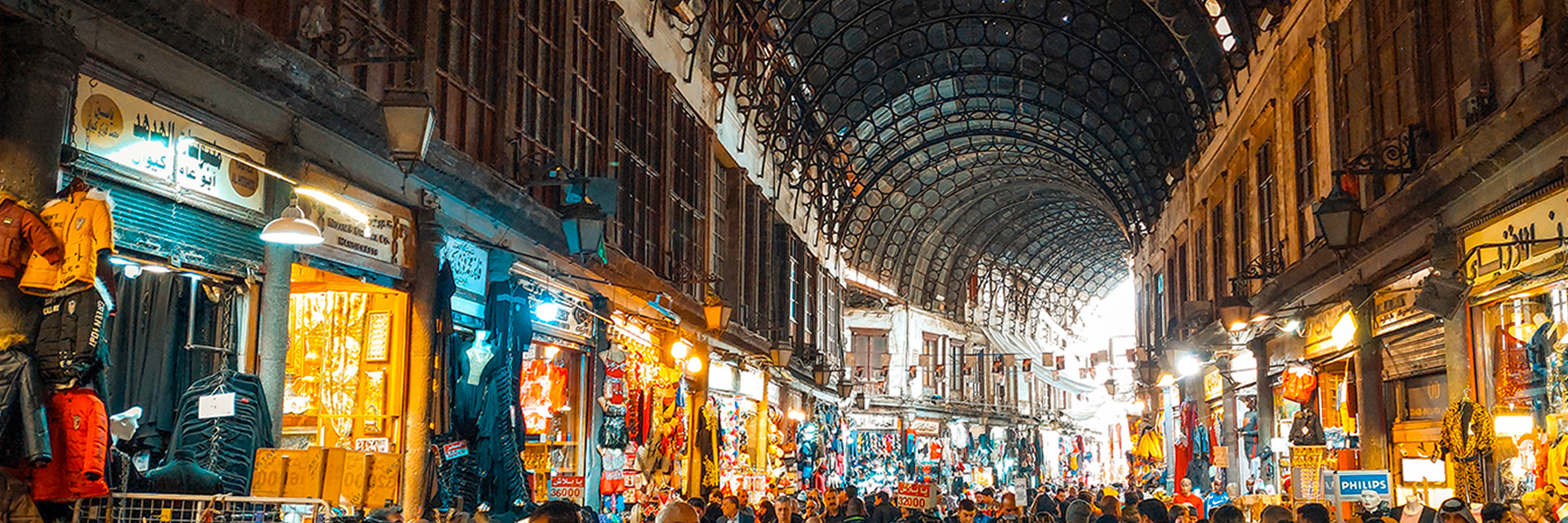Asia
To which language should you translate to localize in Syria?
What we know from our community
“Molo, Dumela, Avuxeni, Aa/Ndaa. That is how you greet in few languages out of the eleven official
languages in South Africa spoken in nine provinces. What is interesting is that from some of the
greetings you can determine whether a person is greeting one person or, two or more people. In some
you can also determine the gender of the person who is greeting.The accents and tradition differ depending on where the speakers reside. You will find that most of the
vernacular languages speaking people in rural areas they have deep accent and are more into tradition
than those who stay in different parts of the country. Also most of them understand their mother
tongue only, while those in other parts of the country are bilingual or know more languages.“
LANGUAGE INSIGHT
Official language
Arabic (78%)
Actual languages
Arabic (78%), Kurdish (11%), Turkish (7.3%), Armenian (1.2%), other (2.5%).
What the top 150 best localized websites in the world do in Syria
(Top 150 websites listed in the Global by Design ranking – published annually by Byte Level Research, this report provides a list of globally localized websites, showcasing best practices and emerging trends in their globalization)
- 14/150 localize by translating into Arabic
-
3M
-
ABB
-
Accenture
-
Adidas
-
Adobe
-
Airbnb
-
Aldi
-
Amazon
-
American Airlines
-
American Express
-
Apple
-
Audi
-
Autodesk
-
Avis
-
Bayer
-
BMW
-
Booking.com
-
Bosch
-
British Airways
-
Bumble
-
Burberry
-
BYD
-
Canon
-
Capgemini
-
Cartier
-
Caterpillar
-
Chevrolet
-
Cisco Systems
-
Citibank
-
Coca-Cola
-
Costco
-
Dell
-
Deloitte
-
Delta
-
DHL
-
Disney+
-
Dyson
-
eBay
-
Eli Lilly
-
Emirates
-
Ernst & Young
-
Facebook
-
FedEx
-
Ford
-
Four Seasons
-
Fujifilm
-
GE
-
Gillette
-
GoDaddy
-
Google
-
Gucci
-
Haier
-
Heineken
-
Hermès
-
Hertz
-
Hilton
-
Hisense
-
Hitachi
-
Honda
-
Hotels.com
-
HP
-
HP Enterprise
-
HSBC
-
Huawei
-
Hyatt
-
Hyundai
-
IBM
-
IKEA
-
Intel
-
InterContinental Hotels
-
J&J
-
Jack Daniel's
-
Jehovah’s Witnesses
-
John Deere
-
Kellogg's
-
Kia
-
KPMG
-
L'Oréal
-
Land Rover
-
LEGO
-
Lenovo
-
Lexus
-
LG
-
Louis Vuitton
-
Lululemon
-
LUSH
-
Marriott
-
MasterCard
-
McDonald's
-
Mercedes-Benz
-
Merck
-
Microsoft
-
Mitsubishi Electric
-
Nestlé
-
Netflix
-
Nike
-
Nikon
-
Nintendo
-
Nio
-
Nissan
-
NIVEA
-
Oracle
-
Pampers
-
Panasonic
-
PayPal
-
Pepsi
-
Pfizer
-
Philips
-
Pitney Bowes
-
Porsche
-
Procter & Gamble
-
PWC
-
Revolut
-
Rolex
-
Royal Caribbean
-
Salesforce
-
Samsung
-
Sanofi
-
SAP
-
Sephora
-
Shopify
-
Siemens
-
Sony
-
Spotify
-
Starbucks
-
Steelcase
-
Stripe
-
Subaru
-
Tesla
-
The Church of Jesus Christ of Latter-day Saints
-
Tiffany
-
Tinder
-
Toshiba
-
Toyota
-
TripAdvisor
-
Uber
-
United Airlines
-
UPS
-
Visa
-
Volkswagen
-
Volvo Cars
-
Vrbo
-
Walmart
-
Western Union
-
Wikipedia
-
Wise
-
WordPress
-
Workday
-
Xerox
-
Xiaomi (Mi)
-
Zara
-
Zoom
If you need others information, below you can find a selection of economic/social/cultural data
Introduction
Language
Official language
Arabic (78%)
Other languages
Kurdish (11%), Turkish (7.3%), Armenian (1.2%), other (2.5%).
T-index
0.035%
T-Index ranks countries according to their potential for online sales.
English
Very low proficiency (EF) – 89 of 100 countries/regions in the world- 7/12 position in the Middle East.
Demography
Capital: Damascus
Currency: Syrian pound
Population: 17.5 m
Population density: 100/km2
Economy
GDP: 21.45 billion USD (2018)
GDP per capita: 1,265.6 USD (2018)
Exports: $49.6 billion (2019)
Statistics
Internet users: 49.2% penetration, 9.25 million
Unemployment rate: 8.18% (2019)
Urbanisation: 54.16% (2018)
Literacy: 80.84% (2018)
Conventions
Numbering system
Arabic numerals are not used.
Date format: dd-mm- yyyy
Time: 24h time system
Country code: 00963
Language data sources: Worldatlas/Britannica//EF/Wikipedia; Demography data sources: IMF/Worldometers; Conventions data source: Wikipedia; Economy data sources: WTO/OEC/CIA/Esomar/Datareportal; Statistics data sources: Datareportal/WorldBank/UN/UNESCO/CEIC/IMF/Culturalatlas/Commisceoglobal
Facts and data
Economy
Imports
$254 billion (2020). Cigars, cheroots, cigarillos and cigarettes; of tobacco or of tobacco substitutes ($506M), Petroleum oils($161M), Cane or beet sugar and chemically pure sucrose, in solid form ($101M), Sun-flower seed, safflower or cotton-seed oil and their fractions ($87M), and Rice ($85.1M), importing mostly from Turkey ($1.42B), China ($834M), United Arab Emirates ($667M), Egypt ($288M), and India ($124M).
Financial inclusion factors (over 15 years of age)
• 87% have an account with a financial institution
• 45% have a credit card
• 21% have a mobile money account
• 60% make online purchases
Ease of doing business
Difficult to conduct business (rated 40.2 out of 100) 18 out of 20 Middle Eastern and Northern African countries 176th worldwide out of 190 countries (2019, World Bank)
Exports
$248 billion (2019). Olive oil and its fractions; ($122M), Seeds of anise, badian, fennel, coriander, cumin, caraway or juniper ($70.5M), Barley ($56.8M), Nuts ($44.5M), and Tomatoes; fresh or chilled ($32M), exporting mostly to Turkey ($236M), Saudi Arabia ($194M), Lebanon ($99.2M), Egypt ($68.6M), and United Arab Emirates ($46.4M).
Economic freedom
‘Mostly free’ (rated 77.6 out of 100) ranked 1st out of14 Middle Eastern countries ranked 9th out of 186 countries worldwide (2019, Heritage Foundation and Wall Street Journal)
Economy data sources: WTO/OEC/CIA/Esomar/Datareportal
Service Exports (2018)
Source: OEC
Service Imports (2018)
Source: OEC
Most specialised products by RCA Index
Specialisation is measured using Revealed Comparative Advantage, an index that takes the ratio between Syria observed and expected exports in each product
Source: OEC
Most complex products by PCI Index
Product Complexity Index measures the knowledge intensity of a product by considering the knowledge intensity of its exporters
Source: OEC
Export Opportunities by Relatedness
Relatedness measures the distance between a country's current exports and each product, the barchart show only products that the Syria is not specialized in
Source: OEC

T-index
Reach most of the online purchasing power
T-Index ranks countries according to their potential for online sales. It estimates the market share of each country in relation to global e-commerce.
Try it nowMedia
Media language Arabic, English, Turkish, French
Information channels
Syria has a complex and changeable media landscape, split between pro-government outlets and those run by armed groups and the unarmed opposition. It remains one of the deadliest countries for journalists. Reporters Without Borders (RSF) says more than 200 journalists have been killed since the conflict began. Media workers have been targeted by armed groups and caught in crossfire. In the first years of the uprising, a new and unregulated media landscape emerged in rebel-held areas. A subsequent loss of territory held by the rebels has forced some opposition media to close or relocate. Islamic State group’s media, largely reliant on the messaging app Telegram, were hit by the fall of its stronghold in Raqqa in 2017. Outlets run by the Kurdish-led authorities, as well as privately-owned satellite TVs and radio stations, have emerged in the mainly-Kurdish region in the north. Satellite TV is the most accessible medium and the preferred news source for Syrians. Opposition networks broadcast from outside Syria. Radio is an important platform for opposition media. Outlets broadcast via the internet and smartphone apps, or on FM in rebel-held areas. The three main newspapers are state-run. Opposition activists have launched newspapers and magazines. Syria had 5.5 million internet users by 2017, representing 29% of the population (InternetWorldStats). Online media have suffered from poor infrastructure, filtering and online surveillance. Social media are used by the government, the opposition and jihadist groups to deliver their messages. Among ordinary users, WhatsApp and Facebook are among the most popular platforms.
The press
Al-Baath – paper of ruling Baath party
Al-Thawra (The Revolution) – government-owned daily
Tishrin (October) – government-owned
The Syria Times – government-owned, in English
Enab Baladi – opposition weekly, based in Turkey
Television
Syrian TV – state-run, operates domestic and satellite networks
Sama TV – private, pro-government
Orient News – opposition, via satellite, based in Dubai
Radio
Radio Damascus – main national state network
Al-Madina FM – first private radio
Syrian Radio Network – opposition/community stations, overseen by German NGO
News agency
Syrian Arab News Agency (Sana) – state-run, in Arabic, English and French
Shaam Network – pro-opposition news site
Media data source: BBC
Internet Data
Internet users
49.2% penetration, 9.25 million
Share of web traffic by device
83.52% mobile phones, 15.31% computers (laptops and desktops), 1.17% tablet devices, others 0.01%
Median speed of mobile Internet connection
11.43 Mbps
Average speed of fixed Internet connection
2.90 Mbps
Mobile connection as a percentage of total population: 78.3%
Percentage of mobile connections that are broadband (3G-5G): 82.1%
Most popular web search engines
Google (98.41%), Bing (1.16%), Petal Search (0.15%), Yahoo (0.12%), Duckduckgo (0.05%), Yandex (0.11%)
Most used social media
Facebook (84.81%), YouTube (10.56%),Twitter (2.92%), Instagram (1.18%), Pinterest (0.46%), Linkedin (0.49%), Reddit (0.04%)
Internet data sources: Datareportal/Statcounter
Social statistics
Life expectancy
70.97 yrs (2017)
Healthcare expenditure
3.5% of GDP
Gender
In Syria, men and women have equal access to the labour market at all levels of the workplace, including high positions in the public and private sector and they receive equal pay. There are many women in Syria’s parliament. However, there are also exceptions to this rule due to a fundamentalist religious movement pervasive in the Middle Easte, including Syria, that has appeared as an anti-Western statement rather than a deep religious belief.
Class
Officially, classes do not exist in Syria. Privileges to influential families and titleholders were cancelled in 1948, after the declaration of independence and the introduction of the new Constitution. All Syrians were declared equal to each other in every right. (Nevertheless, due to the new economic openness of the Syrian economy, a new upper class is emerging).
Average age of the population
25.6 yrs (2020)
Religion
75% of Syrians are Muslims, 13% are Christian and 12% are of different religious sects. Although Syria is a Muslim country, Islamic law does not govern it. People are free to practice their beliefs as long as it does not interfere with public life and the security of others. Syrians are more connected with their Arab heritage rather than their religion and historical religious sites of both religions (mosques, churches and other monuments) are spread all over the Syrian landscape, Muslim and Christian. Religion does not affect the workplace in any way in Syria.
Ethnicity
Ethnicity in Syria is clear and 90% of Syrians are Arabs. Other ethnic groups include Kurds, Armenians and Assyrians. These other groups hold Syrian nationality and are Syrian citizens, although they have their distinct cultures that they incorporate into their Syrian identity at every level of daily life – politically, culturally and economically. This has a positive influence in other ethnic groups that work or live in Syria.
Social statistics sources: WorldBank/UN/UNESCO/CEIC/IMF
The Data Factbook is a work in progress project. Our community is helping us to fill it up always with new and updated data. Your contribution is precious. If you want to help us, please write your advices at imminent@translated.com
Languages research
Arabic in Syria

Legend
-
Iraqi Arabic
-
Nadji Arabic
-
Levantine Arabic
-
Northern Mesopotamian Arabic
The geographical distribution of languages that you will find in the maps published in this section is a work in progress. Our community is helping us to fill it up with always new and updated data. Your contribution is precious. If you want to help us, please write to imminent.factbook@translated.com
photo credit: Mahmoud Sulaiman, Unsplash


